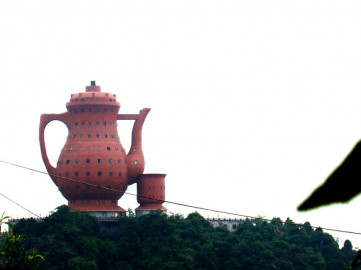The stories behind some of the world’s strangest buildings


Audio By Vocalize
David Mutiso, one of the architects behind the 28-story building famously told Citizen TV in 2018 during its construction in the 1960s, then-president Jomo Kenyatta was highly involved in the construction,
“The president wanted something personal. So he required us to get instructions directly from him,” said Mutiso, who collaborated with Norwegian architect Karl Henrik Nøstvik.
But do you know the stories behind these unusual buildings, or better yet, their existence?
The Meitan Tea Museum in Guizhou, China
Standing 74 meters tall, this might be the world’s largest teapot. Opened in 2010, it is a nod to the Guizhou province of China as ‘the hometown of green tea’.
It boasts 5,000 square meters of floor space.
The Cleveland Clinic- Lou Ruvo Center for Brain Health in Las Vegas, USA
Opened in 2010 this bizarre 5,600 square-meter four-story building serves as an event space for hire, a clinic, and a research center, among others.
“For me, architecture was a necessary marketing tool,” Larry Ruvo, who was involved in scouting the right architect for the building, says. “We wanted a statement that would show we were serious about curing a disease and would let the doctors know we were not underfunded.”
The Longaberger Company Old Headquarters in Newark, USA
This 'large basket’ is the former headquarters of The Longaberger Company, a handcrafted baskets manufacturer. The 16,700 square meters complex has 7 stories.
The Teapot Building in Wuxi, China
China loves its tea and red clay pots and will take every chance to immortalize them in architecture. Built in 2014, the Teapot Building is a 10-story complex housing a cultural exhibition center.
It stands 38.8m tall and according to The Guardian, that the whole structure can rotate!
The Piano and Violin Building in Huainan, China
Made almost fully of black and transparent glass, this building was, interestingly, designed by architectural students at the Hefei University of Technology.
The ‘violin’ houses the elevator and the staircase, while the 'piano' houses the concert halls and it also serves as a practice area for musicians. It was built in 2007 in an effort to improve the economy and encourage tourism in the city.
The Upside-Down House in Szymbark, Poland
This house was designed as a statement about the uncertainty of life in post-Communist era Poland and was completed in 2007.
It is not shocking that visitors reportedly often complain of feeling giddy and nauseous just minutes after they have entered through one of the attic windows and walked on the ceiling.
The ‘Fish Building’ in Hyderabad, India
Opened in 2012, this building houses the National Fisheries Development Board offices. Apart from being, well, offices to a fisheries board, it was actually inspired by Frank Gehry's 1992 ‘Fish’ sculpture.
The three-story, 1,920-square-meter spectacle is completely raised off the ground, through the support of pillars.
The Palais Bulles (Bubble Palace) in France
Built between 1975 and 1989, this quirky house has 13,000 square meters and features forms that look like bubbles.
The architect, Antti Lovag, first designed the Palais Bulles as an experiment. He saw architecture as a “form of play—spontaneous, joyful, full of surprise,” and hated the straight line.
He once called the straight line “an aggression against nature.”
Ripley's Building, Niagara Falls in Canada
This building is one of the museums by Ripley's Believe It or Not; an American franchise dealing with documenting “bizarre events and items so strange and unusual that readers might question the claims.”
It is designed to look like a collapsed Empire State Building with the fictional character King Kong standing on top of it.


Leave a Comment